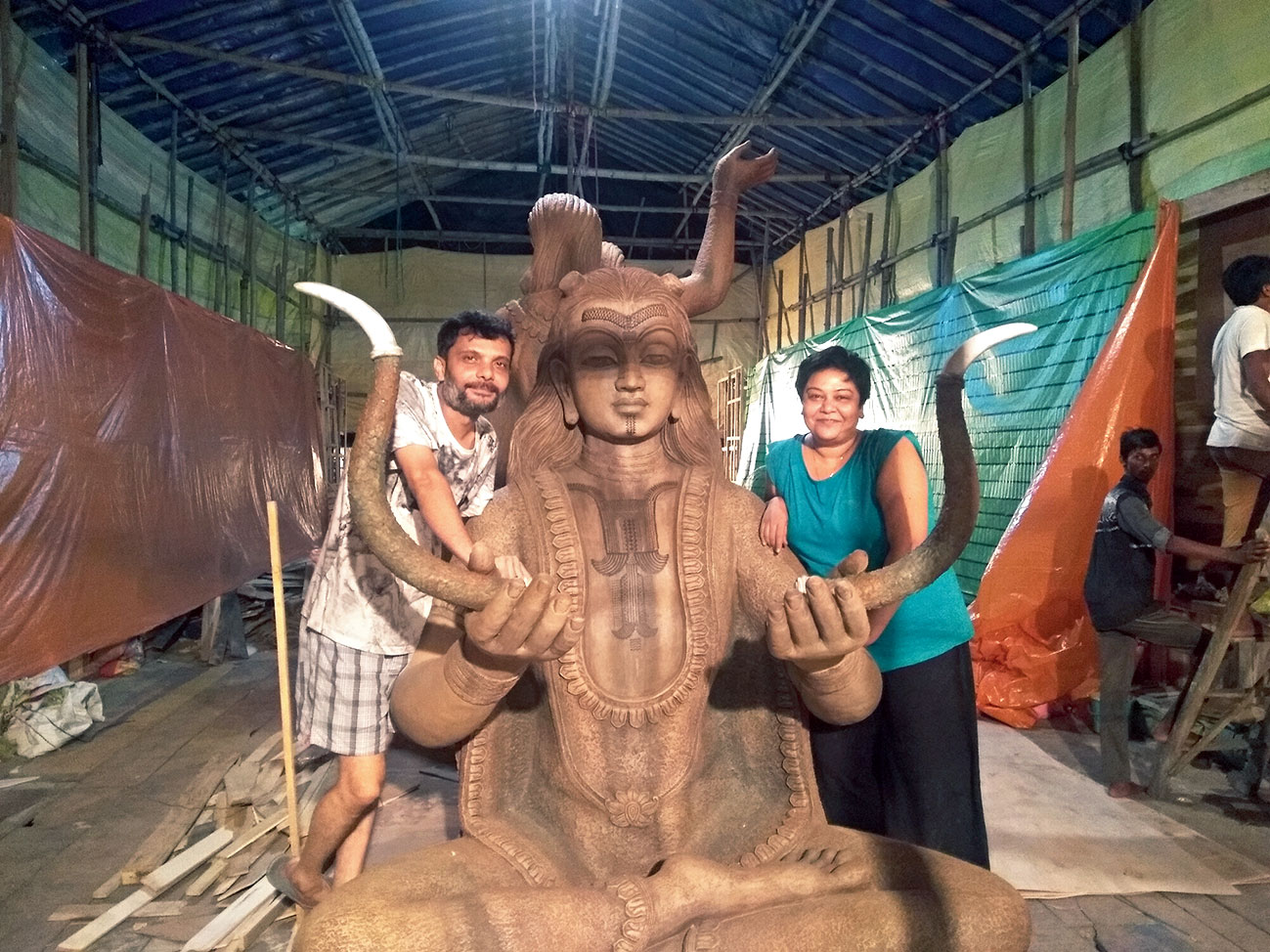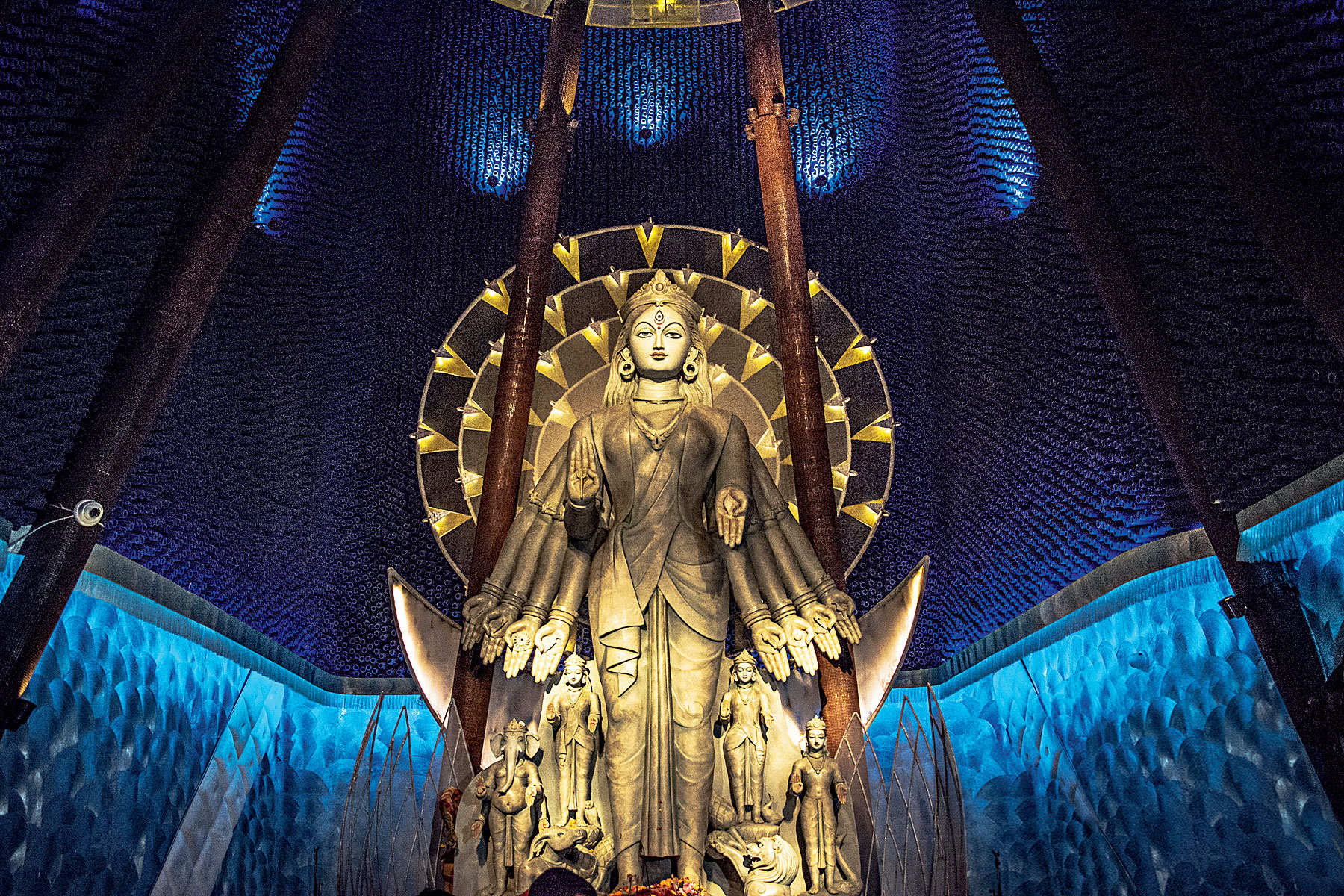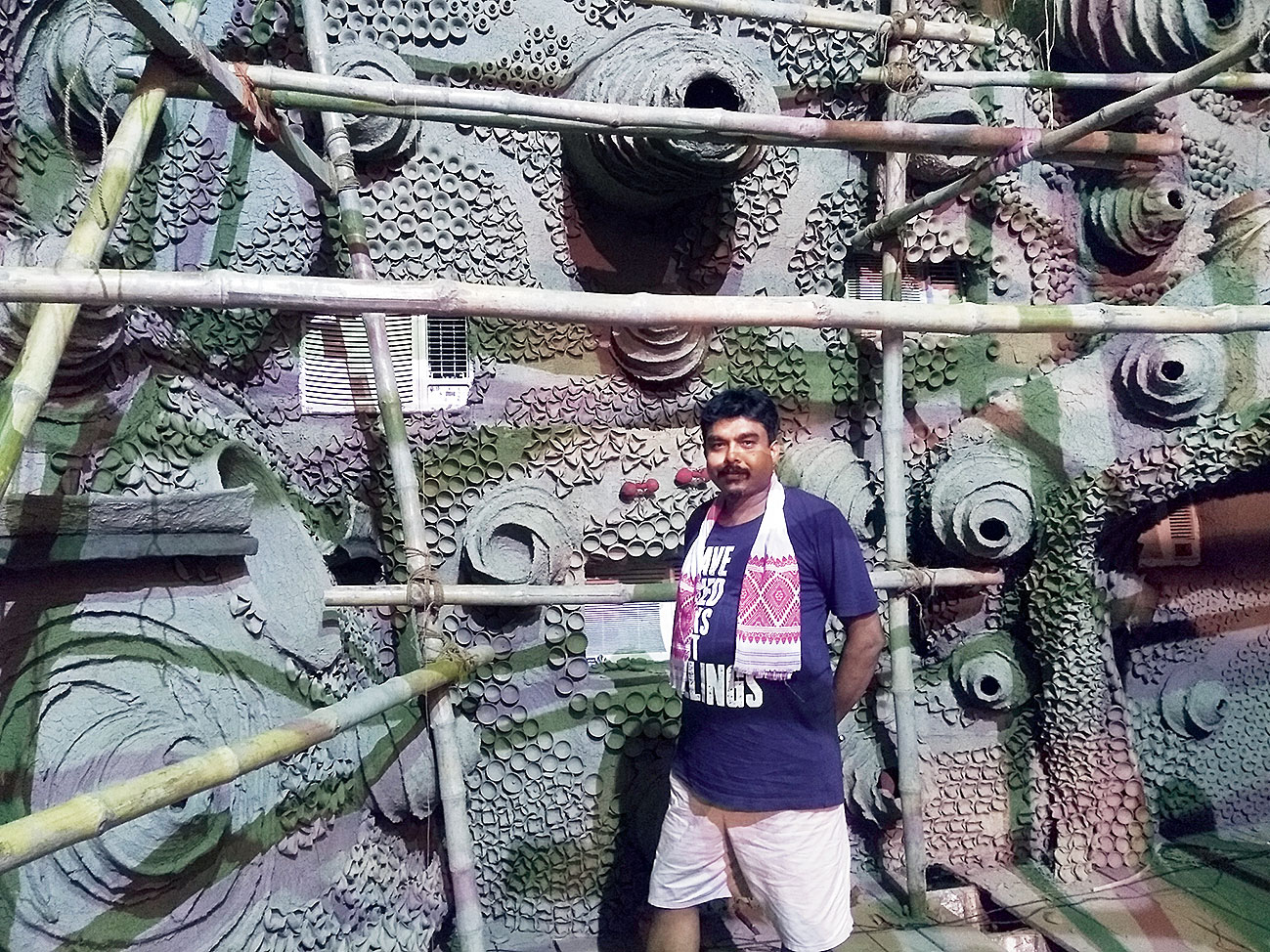
Saumik Chakraborty and Sadhukhan at Bhowanipore Image: The Telegraph
Paintbrushes, sketchpads and cans of oil paint lie amidst sandpapers and stacks of soft wood inside the pandal. At the time of writing this piece, it is still three weeks to the Durga Pujas. A young man in shorts and T-shirt is directing a group of artisans, who are trying to fix a 6 feet by 8 feet clay installation that resembles an ant hill.
Some others are attaching to a bamboo structure what looks like a termite mound. One man daubs crimson paint on something that turns out to be, on closer look, a procession of faux ants. This is the interior of Chorebagan Sarbojonin Durgotsab at Sarada Park in north Calcutta. The man who has imagined it all is sculptor and artist Debatosh Kar.
Kar, who has a master’s degree in Visual Arts, has been working as a Puja artist — one who is responsible for the conceptualisation, design and execution of Durga Puja pandals — for the past six years. For the rest of the year, he does bit jobs with an architect and occasionally participates in an art exhibition here or there. Well-known artists such as Sushanto Paul, Sanatan Dinda and Bhabatosh Sutar, all alumni of Calcutta’s Government College of Art and Craft (GCAC), have started out thus.
This year, the theme of Kar’s Puja project at Sarada Park is an abstract concept called Bileen. Kar says, “Bileen means to dissolve or fade away. Just as everything in the natural world, including humans, are born and melt away, the goddess too arises out of earth and disappears into it.”
Kar is creating the idol and also designing the backdrop. He has a family of 11 potters from a village in East Midnapore assisting him. “The organisers have given me full freedom to execute this. No art gallery or curator will spare so much space or money for an experiment at such a colossal scale,” he tells The Telegraph. He says he gets tremendous artistic satisfaction from the fact that his Puja art attracts thousands of discerning people, while paintings or sculptures in galleries draw just a handful of critics and art lovers.
Purists may shudder at the idea of the Durga idol having deviated so much from its traditional ekchala avatar. (In the ekchala style the images of Durga, her children, Mahisasura et al form a single unit.) But fact is, Kar is one of the 300-plus institutionally trained artists who are transforming the four-day long Pujas into a stunning display of installation art.
A Puja artist chooses a theme, which could be a scene out of a blockbuster like Bahubali or something way more serious like global warming, complete with lighting and sound effects. By thus imbuing the traditional with elements of modern sculpture, architecture and painting, they are altering the visual profile of the Pujas.
Apart from feeding the creative instinct, this experiment also spells good money. Fees range from Rs 5 lakh for a rookie to Rs 1.5 crore for an established artist — after all, big-budget Pujas with political patrons and corporate sponsors can cost up to Rs 10 crore. “For many of us the Durga Puja work has become the principal source of income and the means to support other creative ventures through the rest of the year,” says Kar. “The market for art has gone down drastically in the past few years. All that sells nowadays are pictures of Radha-Krishna or Ganesha,” he adds with a hint of sarcasm.
The city’s bleak art market has led many of the trained artists to look for alternative avenues of work, such as interior decoration, and movie and drama set design.
That day, covered by corrugated iron sheets and a plastic canopy, the work-in-progress pandal of the Dakshin Kolkata Sarbojanin Puja in Bhowanipore looks like a fortress from a distance. We get inside through a side entrance and artist Saumik Chakraborty ushers us into the arena where his partner Piyali Sadhukhan is working on a sculpture of Mahisasura in a meditative pose. The demon is devoid of all atypical beastly attributes. Instead, he has in his hands a pair of horns. Explains Chakraborty, “We are depicting a demon who has peacefully surrendered the marker of his bestiality and power at the feet of the goddess.” The theme of this particular pandal is unity.
Sadhukhan and Chakraborty have come together to work on Puja art time and again for the last five years. They have accepted a contract for a single pandal this year; normally they sign two to three contracts every year. Says Sadhukhan, “Puja art offers us financial stability. It offers us funds for other creative pursuits — painting and sculpting for galleries and art shows.” Adds Chakraborty, “Most of our idols have gone on to be critically acclaimed and in many occasions have been used as magazine covers and advertisement.” That apart, they have made a name as stage designers, for theatre.
Senior sculptor and painter Partha Dasgupta has his own Puja art story. He talks about how in 2005 the organisers of a south Calcutta Puja let him buy cast iron material worth Rs 18 lakh for an installation. He says, “The Pujas enable us to experiment with installations which no art college can finance.”
Dasgupta is a graduate of GCAC and has done his master’s from Santiniketan’s Kala Bhavana. He believes that by getting involved with the Pujas, artists are creating significant pieces of art. “There’s been a silent art revolution in the city during the Pujas, which is now being recognised by art critics in India and abroad.”
He himself revels in the creative freedom that Puja art affords. And that is the case with Debashis Barui too. Last year, his north Calcutta pandal themed on the wanderings of the human mind earned him both critical acclaim and mass applause. He’s been hired by the same organisers this year.
Sadhukhan, however, draws attention to the increasing interference of organisers and sponsors that might impede the free run of creativity Puja art has come to enjoy. She points out that competition at times is so fierce that artists are even refused part of their fee if they fail to bag a certain award. “Organisers once deducted Rs 6.5 lakh because we didn’t crack the award,” she says.
Senior artist and art educator Partha Pratim Deb likens the scenario to the rivalry between football clubs East Bengal and Mohun Bagan. He says, “Star artists are often poached by organisers of a rival camp.”
And while Deb himself never joined the bandwagon of Puja art — he was content with his art practice and teaching — he says he is happy to see the bold art experiments the Pujas yield. He quotes something his teacher Ramkinkar Baij used to say: “Peter daaye art, naa moner daaye art… Art for survival or art for the soul.”
Well, to each his own.

Last year’s Tala Park Prattay pandal, Debashis Barui’s creation Image: The Telegraph










